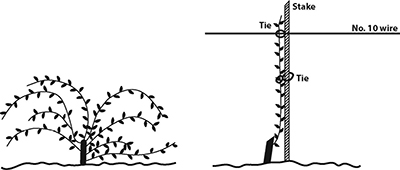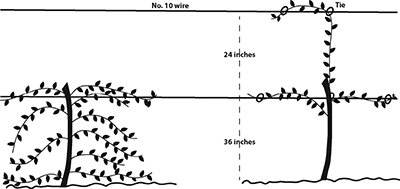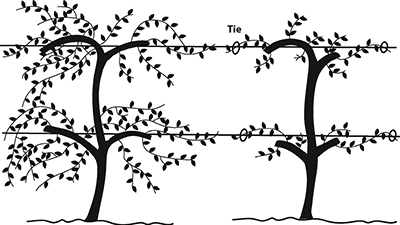Guide H-303
Revised by Gill Giese
College of Agricultural, Consumer and Environmental Sciences, New Mexico State University
Author: Extension Viticulture Specialist, Department of Extension Plant Sciences, New Mexico State University. (Print Friendly PDF)
Pruning can be defined as a dwarfing process where vegetation and/or wood is removed and the plant is made physically smaller. Dormant grapevine pruning is a critical viticultural operation that removes 80 to 90% of the current season’s growth, and is the primary means of regulating crop production in the subsequent season. Light or minimal pruning results in many growing points, weak shoot growth, many small clusters and berries, and poor annual wood maturation. Heavy or severe pruning, leaving few growing points overall, results in excessively vigorous shoot growth, and fewer fruit clusters with relatively large berries. The successful grape grower prunes to direct vine growth to the desired trellis system and to optimize yield and quality over many years. The Kniffin pruning system was devised in 1852 to train Concord grapevines (Vitis labrusca). Despite its relatively high labor requirement, the four-arm Kniffin system is sometimes used in northern New Mexico to train interspecific or French hybrid varieties on sites with low to moderate vigor potential.
Some aspects of grapevine growth and fruiting habit are relevant to effective pruning. Grape clusters are borne on shoots that arise from compound buds located on one-year-old canes. The first four to ten of these buds on a given cane are typically the most fruitful. Select four to six one-year-old canes located near the vine trunk as fruiting canes. These canes should be cut back to leave a total of 30 to 50 buds per vine (about 8–12 buds per cane). A large vine can support 50 buds, whereas a smaller vine will better support 30 buds. Remove all other canes not selected as fruiting canes, leaving three or four two-bud spurs (short canes) near the vine trunk. These “renewal spurs” will produce fruiting canes for the following year. Pruning should be completed during vine dormancy in late winter. If pruning is delayed until early spring, extra care is required to avoid damage to swollen buds and/or young shoots. Sap “bleeding” from pruning cuts does not harm vines; it indicates a healthy vine and the end of dormancy.
At planting, the vine should be cut back to two buds (Figure 1). During the first growing season, tie and train all shoots upward. Immediately prior to the second growing season, select and tie one or two canes to a training stake; these canes will become trunks. Remove all other canes at the crown or above the graft union. Multiple trunks are a proven method for compensating for winter or cold injury. Although vines can grow and produce satisfactorily with a single trunk, multiple trunks can offer “insurance” because often only one trunk is killed or damaged in each cold event. Tie the trunk(s) to the fruiting wire with cloth strips, jute twine, or “plant ties” (Figure 2). Use a loose loop around the cane to avoid girdling the trunk as its girth expands during the growing season. During the second and third dormant seasons, select four fruiting canes, one in each direction on both wires. Do not forget to leave “renewal spurs” as described previously. Wrap the selected fruiting canes 1 1/2 to 2 times around the fruiting wire, tying them to the wire near the end of the cane (Figures 3 and 4). With this “framework” in place, future pruning will be to control vine size and regulate crop load (Figure 5).

Figure 1. Prune newly planted year-old nursery plant to two buds.

Figure 2. First dormant pruning: before pruning (left) and after pruning and tying off the trunk (right).

Figure 3. Second dormant pruning: before pruning (left) and after pruning to select arms (right).

Figure 4. Third dormant pruning: before pruning (left) and after pruning to select arms (right).

Figure 5. Fourth dormant pruning: before (left) and after pruning for vine size and crop load (right).
References:
Reynolds, A.G., and T.K. Wolf. 2008. Pruning and training. In T.K. Wolf (Ed.), Wine grape production guide for eastern North America [NRAES-145], (pp. 98–123). Itaca, NY: NRAES Cooperative Extension.
Dami, I., B. Bordelon, D.D. Ferree, M. Brown, M.A. Ellis, R.N. Williams, and D. Doohan. 2005. Midwest grape production guide [Bulletin 919]. Columbus: The Ohio State University Extension.
For further reading
H-322: Propagation of Grape Vine Cuttings: A Practical Guide
https://pubs.nmsu.edu/_h/H322/
H-331: Trellis End Post Assembly Designs for Vineyards
https://pubs.nmsu.edu//_h/H331/
CR-687: Managing Organic Matter in Farm and Garden Soils
https://pubs.nmsu.edu//_circulars/CR687/
Original authors: Previously reviewed by Ron Byford, Department Head, Extension Plant Sciences; and Esteban Herrera, Extension Horticulturist.

Gill Giese is the Extension Viticulture Specialist and Assistant Professor at NMSU. He earned his Ph.D. at Virginia Tech, and has worked as a commercial winemaker and viticulture/enology instructor. His applied research and Extension work focuses on variety/rootstock evaluation, mitigation of frost/cold damage, soil issues, insects and nematodes, and trellising options to optimize grape yield and berry composition in New Mexico and the arid Southwest.
To find more resources for your business, home, or family, visit the College of Agricultural, Consumer and Environmental Sciences on the World Wide Web at pubs.nmsu.edu/
Contents of publications may be freely reproduced for educational purposes. All other rights reserved. For permission to use publications for other purposes, contact pubs@nmsu.edu or the authors listed on the publication.
New Mexico State University is an equal opportunity/affirmative action employer and educator. NMSU and the U.S. Department of Agriculture cooperating.
Revised April 2018 Las Cruces, NM


